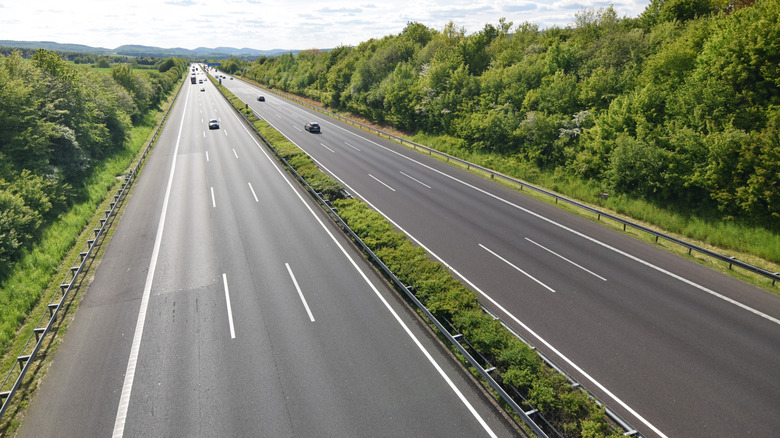Does Germany's Autobahn Have A Speed Limit? The Answer May Surprise You
The answer to whether Germany's Autobahn has a speed limit is — yes and no. While around half of the Autobahn system has no posted speed limits, one-third of the Autobahn has a permanent, posted limit and the other one-sixth has 'variable' speed limits, determined by either traffic congestion or inclement weather. In addition, vehicles such as buses, trucks, and vehicles with trailers are subject to Autobahn speed limits, wherever they may travel. Germany has also decided to give self-driving cars a highway test track on a section of the Autobahn.
In addition, some Autobahn sections have had speed limits imposed on them due to the intense summer heat, which can cause the asphalt roadway to crack and lift. Roads that have been experiencing high traffic volume, are older, or in poor condition are the most susceptible to heat-induced damage. Speed limits on these roadways have been reduced to 120 km/h (74 mph) for most cars and 80 km/h (49 mph) for motorbikes.
On the half of the German Autobahn that has no speed limits, there is an 'advisory' limit of 130 kph or 81 mph. This advisory limit is not enforced, leaving the driving speeds of vehicles on these sections up to the drivers. However, reckless driving on the Autobahn is not tolerated, with the dedicated police force known as the Autobahnpolizei responsible for enforcing good driving standards, regardless of whether or not there is a speed limit.
What else is there to know about Germany's Autobahn?
The patrol cars used by the Autobahnpolizei need to be up to the task of dealing with drivers in high-performance cars who abuse the privilege of high-speed driving. They enforce the laws from behind the wheels of police vehicles suitable for pursuit duties, which have included Porsche 911s, BMW M3s, Mercedes-Benz CLS V12s, and Audi R8, which we can attest, is really fast.
The history of the German Autobahn started long before the Nazis rose to power. The first experimental section was under construction from 1913 to 1921. It was called the Avus, was initially used as a racetrack, and is today a part of the 8,073-mile long German Autobahn system. Avus is also the name of the Audi mid-engine supercar concept we wish made it to production.
There is an 'etiquette' to driving on Germany's Autobahn. It includes driving responsibly, never overtaking other traffic on the right while keeping the left lane clear unless you are passing someone, moving over if someone flashes their headlights from behind, maintaining safe following distances, checking your blind spots, signaling your intentions, obeying any speed limits, blending with traffic, and taking regular breaks. Following this guidance, drivers have reached speeds of more than 250 mph on those parts of the Autobahn where it is safe to do so.

